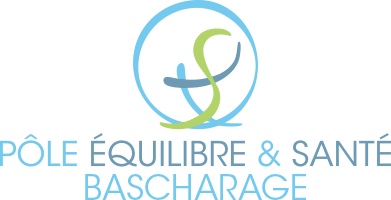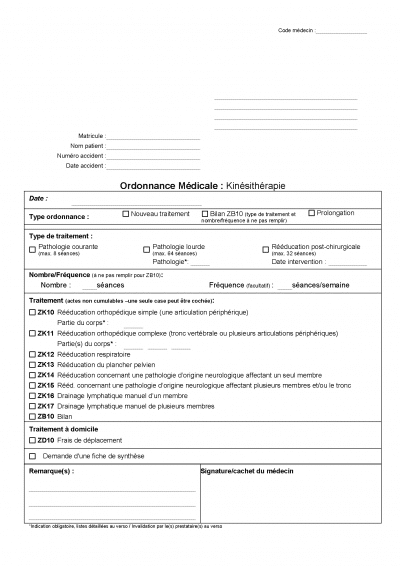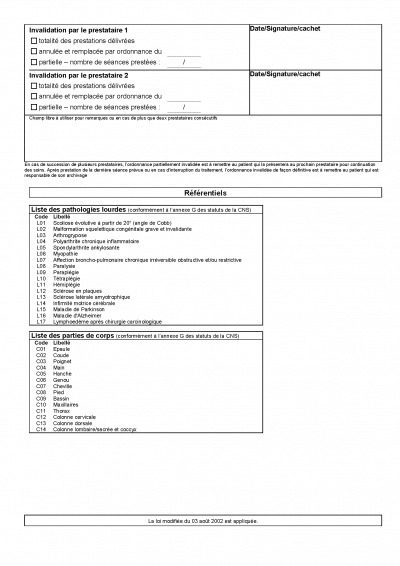Physiotherapy prescription
Authorization procedure
Standardized medical prescription: content and number of sessions
Treatment is prescribed by means of
a standardized physiotherapy prescription
which includes information on the type of treatment, the number and frequency of sessions, and the treatment prescribed.
The maximum number of sessions covered per prescription varies according to the type of treatment, i.e. 8 for a common pathology, 64 for a serious pathology, up to 24 for manual lymphatic drainage and 32 for post-surgical rehabilitation.
Serious pathologies are defined in Appendix G of the Caisse Nationale de Santé bylaws, and are also displayed on the back of the standardized prescription. Any pathology not included in this list, with the exception of post-surgical rehabilitation, is considered a common pathology.
Foreign prescriptions must contain all the mandatory information specified on the standardized prescription, and must be written in French, German or English. Prescriptions written in other languages are returned as they cannot be processed by the CNS.
Foreign doctors can download and fill out a standardized prescription to avoid any refusal. You can download it here :
Prescription validation
The prescription must be validated by the CNS. Generally speaking, the insured person gives the prescription to his or her physiotherapist at the first session, who then takes care of the necessary administrative formalities. If the administrative conditions are met, the CNS validates the prescription. Validation must be requested within 31 days of the date of issue of the medical prescription.
Title de prise en charge
Validation involves the issue of a voucher by the CNS.
The “titre de prise en charge” provides information on the maximum duration of treatment, the number of sessions and the rate of reimbursement.
Treatment must begin within thirty days of the issue of the claim form.
Travel expenses
The physiotherapist’s travel expenses may be reimbursed in the form of a lump sum provided that :
- The doctor indicates on the prescription that it is medically necessary for the physiotherapist to come to the insured person’s home to carry out the treatment.
- The trip takes place on Luxembourg territory. Travel beyond the border is not covered.
Once these conditions have been met, the fee for the trip is charged at the same rate as that applied to the document issued during the trip.
In order to meet our patients’ needs as effectively as possible, but also to offer a quality service, we have launched a Home Physiotherapy service. For more information, please visit our website
MY KINÉ
or call us on 26 26 26 65
Method of payment
Third-party payment system
In this case, the insured person pays the physiotherapist only for the part of the treatment that he or she is responsible for, since the physiotherapist sends an invoice to the CNS at the end of the treatment, to receive the part of the costs borne by the health insurance. The physiotherapist then returns the prescription to the insured and gives him or her a statement of fees, clearly indicating the portion to be paid by the insured and the portion to be paid by the CNS.
The third-party payment system only applies if the request for validation comes directly from the physiotherapist and if the physiotherapy treatment is provided in the Grand Duchy. If the insured requests validation of the prescription from the CNS, or if the physiotherapy treatment is provided outside the Grand Duchy of Luxembourg, the treatment must always be paid for in full, and the portion payable by the health insurance fund is reimbursed on request.
Please note that for cross-border workers, their local health insurance fund is responsible for paying for treatment received in their country of residence.
Advance payment by the insured
In this case, at the end of the treatment, the physiotherapist presents the insured with an invoice showing the total amount to be paid, i.e. the portion payable by the health insurance fund and any portion payable by the insured. After payment, the insured person requests reimbursement of his or her out-of-pocket expenses from the relevant health insurance fund (CNS or public health insurance fund).
To qualify for reimbursement of a physiotherapy bill, the bill must :
- Carry the insured’s registration number, first and last name and the number of the claim form;
- Be validly discharged;
- Be accompanied by the medical prescription.
Coverage rates
The reimbursement rate is set at 70% for procedures related to a common pathology.
Treatments for serious pathologies or post-surgical rehabilitation, as well as treatments for children under 18, are covered at 100%.
Please note: certain supplements for which the physiotherapists’ agreement provides for invoicing are not covered (such as an appointment that is not cancelled).
Procedure for a physiotherapy consultation
The first session or BDK :
The first physiotherapy session involves getting to know the patient. It generally lasts 20 to 30 minutes of tests and techniques, followed by 20 to 30 minutes of physiotherapy/relaxation/exercise.
It is during this session that the masseur-physiotherapist creates your patient file, analyzes your complementary examinations (X-rays, MRI, ….), takes an anamnesis to try to understand the reasons for your visit, taking into account your personal history. history (current health problems, allergies, medical history, medical tests carried out, list of medications, etc.) and by carrying out various physical testsThe most important thing is to be able to do what you want, such as amplitude of movement or suppleness of gesture. It will help you to identify your symptoms and the limitations that affect your daily life. All this will enable us to draw up aDiagnostic Kinesitherapy Report or BDK (in accordance with the medical prescription).
The purpose of this review is twofold:
- Establish a rehabilitation program based on your needs, which can be started at this first session or at the next one.
- Choose the physiotherapy procedures needed to manage the patient. The physiotherapist ensures that the patient adheres permanently to the proposed treatment; if this is not the case, the physiotherapist adapts by using other techniques.
Physiotherapy session:
After the initial check-up, the actual treatment can begin. There are several approaches commonly used in physiotherapy, based on scientific evidence that the physiotherapist adapts to the patient’s needs.
These include :
- Massage involves manual manipulation of the body’s soft tissues, particularly the muscles. Massage can be effective in reducing inflammation and relieving muscle tension and stiffness. Massage has been shown, for example, to speed up recovery from sports injuries.
- Manual lymphatic drainage (MLD) techniques are highly effective in reducing water retention (edema) in body tissue. Edema can accumulate after an injury or operation, but can also be caused by heart problems or the aftermath of illness (most often cancer).
- Exercises and stretches designed to increase strength and mobility are also performed during treatment. When we feel pain, our first reaction is often to keep the area still and move it as little as possible. However, the new uses put forward by scientific evidence indicate that we should try, as far as possible, to move as much as possible. Immobilization leads to muscular deconditioning. These weaken, leading to stiffness that can delay recovery. Your physiotherapist in Bascharage will be able to tell you which exercises are most effective in getting you back into shape as quickly as possible. These exercises can be used, for example, to treat balance disorders (ataxia), muscle wasting (muscular dystrophy), muscular strength, motor disorders and cognitive disorders (associated with motor disorders and to be worked on in a multidisciplinary context). In our practice, you will find a wide range of machines to help you work on your rehabilitation.
- Physiotherapy as :
Electrotherapy
Electrotherapy is the use of electricity for therapeutic purposes.- The
shock waves
Shock waves: extracorporeal acoustic waves are emitted at high intensity. They are characterized by a sudden rise in pressure, rapidly followed by a phase of negative pressure. There are radial and focal shockwaves. - The
ultrasound
Ultrasound: this involves emitting an ultrasound signal strong enough to cause heating to create a defibrosing, analgesic or anti-inflammatory action. - Visit thermotherapy :consists of heat treatment.
- The
cryotherapy
Cryotherapy: cold treatment. - The
lasers
Laser technology is essentially characterized by the effects of cellular bio-stimulation and its healing, analgesic and anti-inflammatory properties. - …
Post-session follow-up :
At the end of your sessions, your physiotherapist in Bascharage can advise you, if necessary, on dietary hygiene and prophylactic measures (stretching, targeted exercises, rest) to ensure that your results last between sessions.
You will then be given detailed exercise and stretching sheets so that you can continue working at home and maintain your health in the best possible condition.



